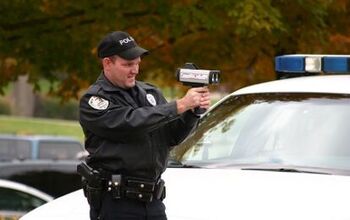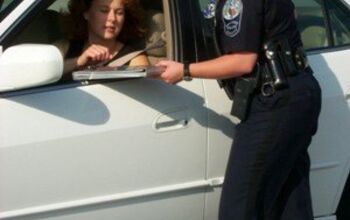The Insider's Guide to Speed Enforcement Pt. 1: A Gunslinger is Born
Is there anything the average motorist hates more than police radar? While some citizens see radar “guns” and those who wield them as a necessary evil– police surveillance that saves lives– most drivers view the technology as a “sin tax,” an ineffective safety device, a waste of police resources, an invasion of privacy and/or a major violation of the Constitutional prohibition against “indiscriminate search.” While the battle for and against police radar (and now laser) rages on, TTAC has invited me to discuss the technology and your legal rights. We begin with some deep background.
Back in the early 60’s, police measured driver’s speed via “S-band” radar. These early devices used a huge antenna mounted on a tripod. It printed a paper read out on a rolling sheet of paper, like a lie detector. The S-band radar unit was a cumbersome contraption that only worked in good weather. And keeping the analogue tubes running was a tricky business– never mind trying to get the waves to live at microwave frequencies. Although the system [eventually] offered its police practitioners a reasonable ROI, it was a major PITA.
With the advent of transistors, radar moved to the 10 Ghz “X-band.” New solid state devices assured greater frequency stability at higher frequencies. The antennas got smaller. For the first time, police could mount a radar device on their car– although they were still restricted to continuous transmission from a stationary position.
Early Escort radar detectors worked a treat, picking-up the X-band signal a mile or more before it had the strength to bounce back to its police handler. And there were few, if any, radar “falses” from door openers. The detection – detector arms race began.
The next advance on the police side: a 24 Ghz “K-band” device with a smaller antenna with a new mode: ”instant on.” This feature made the radar detector less useful (it still triggered when someone up ahead was zapped). K-band radar guns were very expensive when they first appeared– so the older X-band guns were also rigged for “instant on.”
The next advancement: moving mode. For the first time, a radar device could separate the primary reflection (ground speed) from the second reflection (target speed). (This development mystifies a lot of drivers, amazed that the cop “was coming from the opposite direction.”) With the smaller. squad car-borne K-band antenna, any police car was a potential "threat" to a speeding driver. The modern radar enforcement era was born.
Today’s state-of-the-art radar devices have moved still further up in frequency, to the 34-36 Ghz Ka-band. (The Ka band is much wider than X or K, making the radar detector’s job harder, as it’s really just a glorified scanner.) Police radar antennas have miniaturized to the point where they’re hand-held devices with soda can-sized apertures. The entire speed detection device is now small enough to permanently mount in a squad car; many police departments use front AND rear antennas.
Whereas the primitive radars of the 70’s could pick out target vs. ground speed as they were going in opposite directions, today’s radars can pick out a target going in the same direction as the patrol car. State laws vary in whether or not this mode has “judicial notice” (i.e. would be accepted in a Court with the usual minimal Police testimony). But the bottom line remains the same: a police car behind you or in front of you can now get a reading. This mode is less frequently used, but it’s increasing, as the older units are retired and new ones enter active duty.
Police radar devices are sold through a public bidding process at the State level. Your local law enforcement agencies often buy at the negotiated State Police price. Many agencies, though, do not. If your state does not have an “official” radar device, you are facing a variety of threats.
Here in New York, the State Police use a state-of-the-art Ka-band radar gun called (of course) the Stalker. Local agencies still have a lot of the Kustom Signals KR series K-band units; they have less money than the State and the units last a bit longer in regular use. Ye Olde X-band is mostly gone; the units have obsoleted out.
The newer radar units have variable power outputs, so that the officer can make the unit’s “zone of influence” smaller. Many of them allow the relevant law enforcement agency to lock out certain functions (e.g. the moving modes) if the law in their state does not support their use.
Fortunately, most police are not gadget geeks. They tend to run their radar guns in full power mode, in standard stationary or “instant on” modes. Still, there's never a shortage of sheep to shear. Speaking of which, next week’s installment will focus on countermeasures– sorry, effective ways to check your speed before you get a ticket.
[Casey W. Raskob, Esq. is a NY-based lawyer who runs speedlaw.net]
More by Casey W. Raskob
Latest Car Reviews
Read moreLatest Product Reviews
Read moreRecent Comments
- Rochester I recently test drove the Maverick and can confirm your pros & cons list. Spot on.
- ToolGuy TG likes price reductions.
- ToolGuy I could go for a Mustang with a Subaru powertrain. (Maybe some additional ground clearance.)
- ToolGuy Does Tim Healey care about TTAC? 😉
- ToolGuy I am slashing my food budget by 1%.


































Comments
Join the conversation
I have two methods (both very similar) that has worked at least 10 times. I have received one ticket since 1988 in the USA. We used to trip the speed cameras in Italy for fun b/c the ticket always came in the form of a registered letter that we were supposed to pickup at the local Italian post office. Never picked them up, never got a ticket. Anyhow... Like a previous poster wrote - speeding over short distances has never netted me any real time. 10 minutes city to city maybe so the older I get the more likely I am to cool it. Frankly I have better things to do with $250 and higher insurance costs. When I have felt like I needed to speed - I have always drove the speed limit until some brave soul passed me. Then I hang back a couple of miles and pace them at the higher speed. I have witnessed about 5 or 6 of these "Rabbits" (I call the car I'm chasing a rabbit) get pulled over. Once the officer didn't hit the lights until he past the rabbit and was beside me. I pulled over b/c I thought I was caught! Another version (2nd method) is to simply do this with a radar detector. Has worked very well except I got my one speeding ticket this way. I was "chasing" a knot of rabbits on I-81 in VA going south one day. I let them get too far ahead (they were running about 80 mph) and we were traveling through some hills. They apparently got off the interstate somewhere leaving me alone running about 80 mph. I came over a hill and there was VA's finest shooting radar in my direction. Instant on of course. My radar detector which usually would beep faster and faster as I approached a radar gun skipped all that and went berserk. I just pulled over and hid the hardware. Took my ticket and went on. Really there is a place for everything. Dense traffic or country highways with blind hills and driveways isn't the place to go fast. Empty rural highways where you can see for miles with big road shoulders - lay on the steam. I miss being able to get on the Autostrada and run 100 mph for a few hours in my 1984 Rabbit Convertible. I tried it here (TN) for fun and frankly the American driver doesn't know what to do with themselves when a fast car catches up with them around here. If I flash my high beams at them there is a 50% chance they are going to get pissed off and hold on to that left lane b/c they can. A flashing left blinker in the left lane means squat (useful in Italy). A good number of the cars are best left running at 70 mph because they are not capable of running any faster safely due to either equipment or driver deficiencies. An SUV or minivan running 90 mph? No thanks... Give 'em some space to crash everybody! So I've learned to be patient. What I WOULD like to see is slower commercial traffic. A 60,000 lb truck running 80 mph is dangerous for everyone around it. I'd love to see them restricted (computerized) to 65 mph. Let them have full power to climb hills but speed limited to 65 mph or lower. I'll pay the slightly higher costs at the store if that is what it would mean. I'd also like to see the bumpers under the trailers that the Italian truckers were required to have. These were large plastic or fiberglass bumpers that kept anything front going under the trailer. I think if the American fleet of vehicles begins to shrink (high fuel costs) this would be doubly good.